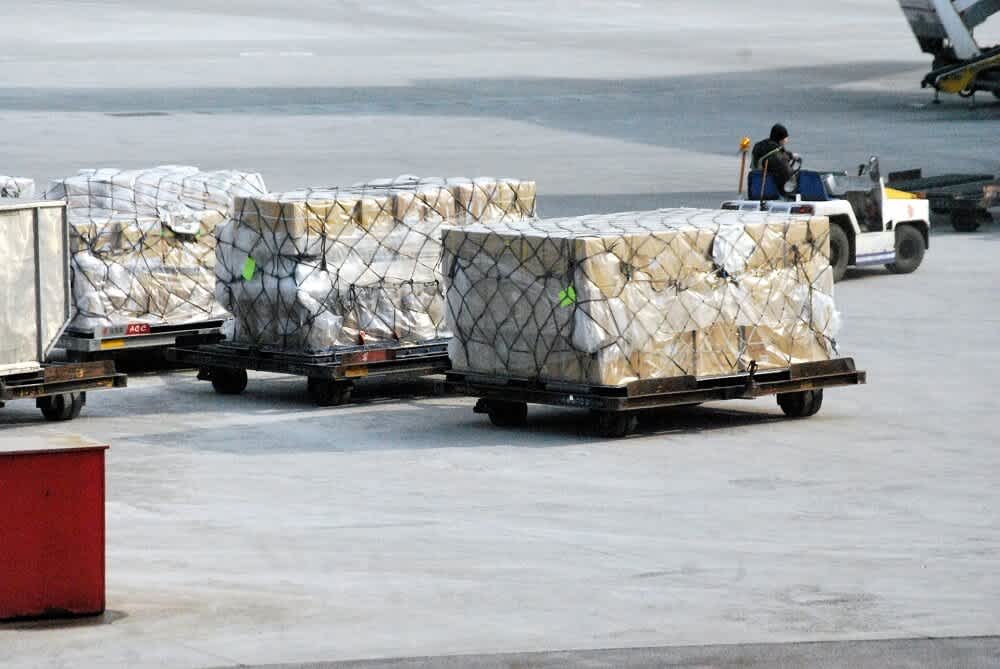
by Sam Franklin | September 19, 2022 | 17 min read
How does order fulfilment work? Process strategies you need to know all about
Get fundedLast updated: October 06, 2022
When an order comes into your eCommerce store, the process of collecting the products, packaging them, and shipping them out to the customer is known as order fulfilment. Typically, smaller businesses do what is known as ‘In-House’ order fulfilment, where they manage their own packaging and shipping.
As businesses begin to grow, inventory management and the amount of work that order fulfilment takes will become too much for one person to deal with. At this point, instead of shipping orders out of their home or office, they’ll partner with a third-party order fulfilment centre. This third-party fulfilment facility will then manage every step of the process on behalf of the business.
Once this partnership has been established, an eCommerce website can focus on scaling its business without worrying about packaging and shipping all the orders that come in. Quite simply, order fulfilment is about streamlining the logistics planning and execution that an online business requires.
Table of contents
- How does the order fulfilment process work?
- What types of order fulfilment are there?
- What are the benefits of order fulfilment?
- What are the biggest challenges of order fulfilment?
- Best practises for improving the order fulfilment process
- Final thoughts on order fulfilment
How does the order fulfilment process work?
When working with a third-party logistics provider, there are several steps to the operation. While your order fulfilment partner will take care of most of these, that doesn’t mean there isn’t any upfront work for you.
When tracing the entire order fulfilment process, there are six core steps that move from the moment you send your inventory to the fulfilment centre to the moment a package arrives at a customer’s address.
Ship inventory
Order arrival
Picking products
Packaging
Shipping
Returns
Let’s break down each of these steps.
Ship inventory
When working with a fulfilment service, you must ensure they have access to your inventory. This commonly involves an eCommerce company shipping large batches of their stock to the fulfilment centre. Depending on the fulfilment model a business uses, the quantity of product sent at any one time may vary.
Depending on how quickly sales are coming in and how much space storing inventory takes up, it might be better to send products every month, every three months, or maybe even every week. No matter how much product you have to shift, the order fulfilment process will always start with the eCommerce vendor shipping their products to the fulfilment centre.
Once it has arrived, the partner will take care of the rest of the order fulfilment process.
Processing inventory
The first stage of the order fulfilment process that the fulfilment service will take care of is processing the inventory that arrives to them. Typically, alongside positioning everything in an accessible location on the shelves, a core part of this stage is giving every product a barcode. With this barcode, the fulfilment facility can track the product, helping to give updates to the eCommerce store when they are running low.
Depending on the size and fragility of the products, they are either stored in product bins or on the shelves in palettes. More complex order fulfilment services will have online platforms to which they connect the products, allowing eCommerce business owners to better understand where their products are being held and in what conditions.
Order arrival
Once a customer orders from your eCommerce store, the order information will be directly passed on to the fulfilment partner. While you’ll be able to see orders as they come in, you won’t have to act upon them, with the order fulfilment process happening exclusively in the facility partner.
In each order, the fulfilment provider will get a detailed breakdown of all the products involved. From there, they will move into action.
Picking products
With the detailed order description, the fulfilment service will then move through their facility, selecting all of the products the customer ordered. This part of the order fulfilment process is all about collection, with the employees of the fulfilment team making sure that all of the products on the customer’s order are picked and transported to an area where the next step can then take place. Without this picking list, the warehouse won’t know what’s involved in a product order.
While fulfilment operations will vary depending on the partner themselves, this process typically takes place within 0-48 hours after the order has come through. The very best order fulfilment centres will mobilise instantly, while some services may take up to 48 hours to begin to process the order.
Packaging
Once all the items within the order are delivered to the packaging bay, they are double-checked. This step ensures that the customer will receive exactly what they ordered. After this short period of confirmation, the employees will then begin to package the order into either generic packages or custom boxes that the eCommerce company previously supplied.
Collecting all of the products together and packaging them also provides the order fulfilment service with the opportunity of adding any additional promotional materials. Many companies will add a leaflet or brand promotion, which is a great opportunity for the eCommerce company to go above and beyond the customer expectations and impress them.
Finally, the fulfilment team will print and attach a shipping label, details of which will also be included in the order script.
Shipping
To finish the order fulfilment process, the team will ensure the package is loaded onto a carrier. Typically, fulfilment facilities will either have their own delivery services or have formed partnerships with logistics companies they then work with.
Whichever route they take, the package will be loaded onto a freight carrier or transportation vehicle and will then begin the process of arriving at the required address. Depending on their location, as well as the quality or speed of the service, this could take anywhere between 24 hours and upwards of a week.
Returns
Although the vast majority of order journeys will finish with the previous step, some packages are returned either due to defective products, a lack of customer satisfaction, or, very rarely, being delivered to the wrong address.
Not all third-party fulfilment facilities will handle returns. In that case, the package will have to be routed back to your main offices for processing. However, if the fulfilment model includes returns, then the customer only needs to send their package back to the centre.
From there, the fulfilment team will assess the products in the package for quality or possible defects. If the products are still in great condition, they will be returned to the shelves and reprocessed, ready for a new customer. If they fail quality assurance tests, the products will either be disposed of or returned to the eCommerce seller.
With these steps, the entire fulfilment process is covered, tracing the entire journey from the moment a customer checks out to the moment their package arrives at their door.
What types of order fulfilment are there?
While the vast majority of order fulfilment follows the steps outlined above, that isn’t always the case for some businesses. As we have previously discussed, many smaller businesses will opt for in-house fulfilment at the beginning of their development. As a great option for businesses that aren’t currently processing many orders at once, this is a sustainable and low-cost solution to the logistics process.
As companies continue to grow, they often shift to third-party fulfilment, which we have outlined above. Yet, there is also one other form of order fulfilment that is becoming increasingly common in recent years.
Dropshipping is where a business creates a partnership with a manufacturer. Instead of buying products and sending them to their business for shipping, they create a deal where the manufacturer will automatically ship the products directly to the customers.
Currently, around 27% of all online retailers use dropshipping in some format, which is a very accessible method of running your business. Typically, because this doesn’t require a business owner to spend lots of money on initial stock, this low-barrier-to-entry system is very attractive to new business owners. Equally, with the proliferation and wide success of online manufacturer retailers like Alibaba, finding a partner is now easier than ever before.
What are the benefits of order fulfilment?
Order fulfilment is not a new concept. In fact, order fulfilment strategies have been around since the late 1800s, with this business format being traced back to 1872. With a business model that has been thriving for 150 years, it’s no wonder that it comes with a range of benefits for business owners.
There are four main benefits when working with an order processing and fulfilment partner:
Lower costs
Improves customer satisfaction
Scale business
Faster shipping
Let’s break these down further.
Lower costs
When starting an eCommerce company, many people lack the connections with logistics partners to secure them any form of a discount on their shipping. Even when working through international brands that offer a discount for shipping many products at once, the percentage saved is still negligible in the long term.
However, when outsourcing order fulfilment, brands can take advantage of the established relationships that fulfilment facilities and logistics companies have created. For example, many of the leading fulfilment centres have partnerships with leading experts in the field, having secured major discounts that the eCommerce company can then take advantage of.
Especially considering that eCommerce companies must simply ship their products to create income, saving money on every single package that leaves through the doors is a fantastic way of increasing total profit by lowering costs.
Improves customer satisfaction
Many third-party logistics partners have been around for years, creating a flawless business model. Quite simply, these partners are fantastic at what they do, allowing eCommerce organisations to access a flawless level of quality assurance. These partners will ensure that every package they process is treated with care; each product is carefully managed and packaged precisely.
With attention to detail being a huge part of the order fulfilment model, these partners will ensure that the address the customer supplied is the one where the package ends up, that all items are included, and that products are packaged carefully to ensure nothing breaks on the way.
Over time, this higher quality of care will ensure your customer satisfaction continues to increase. Package branding is a fantastic way of impressing your customers, with this being an opportunity to use the resources that your logistics partners have available to really drive home the perfect customer experience.
Scale business
When a company owner decides to use in-house fulfilment, they have to allocate time in the day where they sit down to collect products, assemble packages, print shipping labels, and visit the post office to send parcels. When a company is only receiving a few orders each day, this is a fairly manageable system.
Although it takes time out of the day, with only a few packages to process, this isn’t a huge problem for business owners. However, as the business starts to pull in more customers, the window of time that is spent packaging products continues to grow. Rather quickly, business owners arrive at a point where they’re spending more time packaging than actually running their company.
At this point, scaling further becomes unsustainable, forcing business owners to either hire an employee to manage shipping or turn to a third-party solution. When they go with the latter, they are instantly able to liberate their day - potentially hours of work - from the task of order picking and packaging.
Instead of spending a few hours each day covering these logistical services, business owners can instead focus on actually running their business. Without needing to ship orders themselves, they can scale their business without worrying if they can keep up with the order load.
Every eCommerce order will be managed by the order fulfilment centre, meaning that the business owner can focus on gaining more customers. Whether that be by refining their marketing strategy or increasing their product range offering, not having the additional task of shipping sets business owners free to work on their business as they see fit.
Faster shipping
Much like the cheaper shipping costs that third-party order fulfilment can provide, they can often get your packages to customers faster. The ability to ship quickly comes from two main factors:
3PL Partners - Third-party logistics partners often have established partnerships with nationwide shipping companies, using these connections to get packages delivered in a matter of a few days.
Positioning - Most 3PL services open their facilities in an optimum location for rapid shipping. Instead of being nestled in the corner of a country, a central location allows them to reach all corners of your home country as quickly as possible.
Faster shipping is one of the most essential benefits of forming this partnership, as fast delivery is a leading cause of high customer satisfaction. In fact, 44% of customers are willing to wait two days for a package, while only 25% will wait up to 4 days. The rapid decline in time here demonstrates just how quickly customers want their packages.
If you’re unable to deliver your products rapidly, customer satisfaction will start to decline.
What are the biggest challenges of order fulfilment?
Although order fulfilment and inventory management allow companies to increase the speed and efficiency of their logistics while lowering cost, that doesn’t mean this system comes without its own unique set of challenges.
From supply chain execution to managerial or communication issues, there are several challenges that business owners will come to recognise:
Inventory Management - Although many warehouses will offer management tools, keeping on top of many different products and their current levels in the warehouse can become a considerable task. Order fulfilment should be a continual process, meaning business owners need to understand how to manage and order more inventory to keep their fulfilment strategy flowing.
Planning Around Demand - Different seasons throughout the year will increase or decrease the demand for certain products. Accommodating these changes involves a detailed understanding of your business and how it adapts over the year. Business owners should have a thorough understanding of their company's annual product fluctuations to be able to order products at the right time.
Supply Chain (running out of products) - Part of supply chain management is ensuring that the order fulfilment doesn’t stop at any point. Managing sales channels and ensuring complete visualisation across both the online store and the supply chain fulfilment process managed by the logistics partner is no small task. Business owners must have phenomenal organisational skills to make this work effectively.
However, business owners can effectively overcome these challenges if they plan ahead, understand their processes, and get to grips with the best shipping strategies. Once neutralised, the benefits of order fulfilment significantly outweigh the drawbacks, making this an invaluable opportunity for scaling a business.
Best practises for improving the order fulfilment process
While the majority of order fulfilment companies will have an out-of-the-box solution for eCommerce companies to work with, that doesn’t mean business owners can’t streamline the process to make it even more efficient. If you’re already working with an order fulfilment partner, then you should move through these four steps to see if there’s anywhere you can improve the process.
Integrate OMS seamlessly
Set up product information triggers
Ask about warehouse locations
Ensure you provide a returns system
Each of these is vitally important and can hugely impact the overall success of your eCommerce order processing strategy.
Integrate OMS seamlessly to help with inventory management All eCommerce platforms have a built-in order management system that collects information about their orders, what products are in each purchase, and customer data. The first step of partnering with a third-party logistics provider should be to ensure their systems are completely synchronised with yours. Remember, creating this partnership is about making your life easier, reducing the amount of work you have to put into logistics and providing a fantastic customer experience. If you have to send information about each order that comes in manually to your partner, this is creating extra work for you, which won’t help anyone. Be sure to create order fulfilment that automatically transfers data from your eCommerce store to the fulfilment infrastructure that you have in place. The entire process should be as automatic as possible, with your fulfilment process being naturally flowing between you and your 3PL partner. Especially if you have multiple sales channels, making this complex process automatic is by far the most necessary part of outsourcing fulfilment and shipping.
Set up product information triggers Much like how you want to give your partner access to your order system, you should also request a level of access to their warehouse management platform. The most complicated part of outsourcing shipping is ensuring you always have enough products in stock. Nothing is more frustrating for customers when they go to check out and realise that one of the products they want is currently out of stock. When you have access to the warehouse system, you can ask them to send you alerts when certain products are running low. From there, the process of the warehouse receiving inventory is simplified, with you only needing to act when one of these notifications comes through. This means you’ll have to spend less time thinking about your products and ensures your loyal customers always have access to the items they love, with the warehouse never running out of products.
Ask about warehouse locations One of the most undervalued aspects of working with warehouse and shipping providers is the fact that many established companies don’t only have one singular location. While they may have a default warehouse where all products are stored, they might have fulfilment centres around the country. If this is the case, you could send products to different areas within the company. With a more streamlined delivery process, you’ll be able to get your products out to customers at a much faster speed. Considering the importance of fast shipping while keeping shipping costs down, working from many different warehouses could be a valuable strategy you use to keep your customers happy. Alongside location, different warehouse branches may have access to different shipping methods or entirely distinct shipping carriers, which could further lead to faster delivery times for your business.
Ensure you provide a returns system to align with customer expectations As online shopping becomes even more of an internationally used practice, the number of packages returned each year equally grows. Currently, 30% of all online orders are returned by customers, meaning that your online store should endeavour to offer this function. The vast majority of providers can accommodate returns, but you should ensure that the fulfilment service you partner with is one of these. An inability to process returns will lead to you having to deal with this part of the logistics process. Not only does this create more work for you, but the additional return steps will cause customer dissatisfaction with your company. If the warehouse setup doesn’t accommodate returns, this is a point that you should take into consideration when forming a partnership with a logistics company. Due to the importance and increasing demand for a returns structure, this is something that you should make a priority. Whether it be from customers not liking a product, a package arriving to the wrong customer, or another issue that leads to a return, you must have this infrastructure in place. With this in place, customer service issues will decrease as customers can instantly get access to the returns they want.
Final thoughts on order fulfilment
When done correctly, working with an order fulfilment centre can be one of the most effective ways of streamlining the logistics side of your business. Instead of having to think about picking and packaging products, your 3PL partner will take care of absolutely everything.
After optimising your partnership, you’ll be able to quickly and cost-effectively send your products out to your customers. With unbridled room for scaling and a promise of satisfied customers, order fulfilment is well worth doing for any business that’s ready to grow.
Written by

Sam founded his first startup back in 2010 and has since been building startups in the Content Marketing, SEO, eCommerce and SaaS verticals. Sam is a generalist with deep knowledge of lead generation and scaling acquisition and sales.


